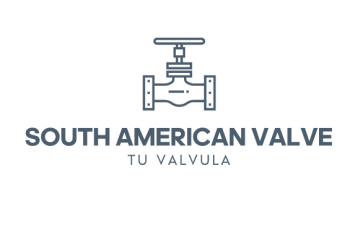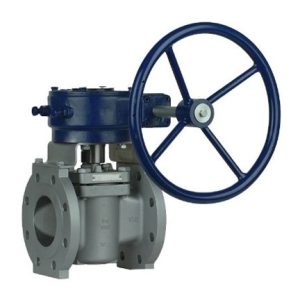Plug Valve
South American Valve is a leading Plug Valve Manufacturer in Mexico. A plug valve is a quarter-turn valve used to regulate the flow of liquids, gases, or slurries in a piping system. It consists of a valve body, a plug, and an actuator. The plug has a hollow cylindrical or tapered shape and is inserted into the valve body. The actuator rotates the plug by 90 degrees, which opens or closes the valve. Plug valves are commonly used in industries such as oil and gas, petrochemicals, and water treatment, where they are preferred for their reliability and ease of operation. They are suitable for applications that require high-pressure and high-temperature resistance, and where frequent cycling is necessary.
Applications
- Oil and gas industry: Plug valves are widely used in the oil and gas industry for applications such as wellhead control, pipeline transport, refining, and processing. They are preferred for their high-pressure and high-temperature resistance, and their ability to handle abrasive fluids and slurries.
- Chemical industry: The chemical industry uses plug valves for applications such as chemical processing, refining, and transportation. They are suitable for corrosive and abrasive fluids, and they can handle a wide range of temperatures and pressures.
- Water treatment: Plug valves are used in water treatment facilities for applications such as water distribution, wastewater treatment, and desalination. They are suitable for handling a variety of fluids, including sewage and sludge.
- Power generation: Plug valves are used in power generation plants for applications such as steam distribution, cooling water systems, and fuel handling. They are preferred for their reliability and ability to handle high-temperature and high-pressure fluids.
- Pulp and paper industry: The pulp and paper industry uses plug valves for applications such as pulp processing, chemical recovery, and wastewater treatment. They are preferred for their ability to handle abrasive and corrosive fluids.
Types
- Lubricated plug valve: This type of plug valve has a tapered or cylindrical plug that is coated with lubricant to reduce friction and wear. The lubrication also provides a tight seal and helps to prevent leakage.
- Non-lubricated plug valve: This type of plug valve does not require lubrication as it uses a self-lubricating mechanism, such as a PTFE sleeve or coating, to reduce friction and wear. It is suitable for applications that require minimal maintenance and lower operating costs.
- Sleeved plug valve: This type of plug valve has a flexible sleeve or lining that provides a tight seal and prevents leakage. The sleeve is made of materials such as rubber or PTFE and is replaceable, which makes maintenance easy.
- Eccentric plug valve: This type of plug valve has an offset or eccentric plug that allows for a high degree of throttling and control. The eccentric design reduces the amount of friction and wear on the valve, making it suitable for applications that require precise flow control.
- Multi-port plug valve: This type of plug valve has multiple ports that allow for multiple flow directions or diverting flow. It is suitable for applications that require complex flow configurations.
- Quick opening plug valve: This type of plug valve has a plug that can be quickly opened or closed by rotating it 90 degrees. It is suitable for applications that require fast response times, such as emergency shutdown systems.
Advantages
- Tight seal: Plug valves provide a tight seal, which minimizes the risk of leakage and ensures that the fluid flows through the valve in a controlled manner.
- Simple design: Plug valves have a simple design that makes them easy to install, operate, and maintain. They also have fewer moving parts than other types of valves, which reduces the risk of mechanical failure.
- High-pressure and high-temperature resistance: Plug valves are suitable for high-pressure and high-temperature applications, making them ideal for industries such as oil and gas, chemical, and power generation.
- Abrasion and corrosion resistance: Some types of plug valves are designed to handle abrasive and corrosive fluids, making them suitable for applications where these conditions are present.
- Throttling capability: Some types of plug valves, such as the eccentric plug valve, have a high degree of throttling capability, making them suitable for applications that require precise flow control.
- Versatility: Plug valves can be used for a wide range of applications, including oil and gas, chemical processing, water treatment, and power generation.
- Cost-effective: Plug valves are generally cost-effective, especially when compared to other types of valves that require more maintenance or have higher initial costs.
Description
- Material: Carbon Steel, Iron, Duplex Steel, CF8, CF8M, WCB, CF3, CF3M, WC6, Ductile iron, WCC, LCB, LCC, SS304, SS316, Alloy 20
- Class: 150 to 2500.
- Pressure: PN10 to PN450.
- Nominal Size: ½” to 24”
- Ends: Flanged, Threaded, Socket weld, Buttweld
- Operations – Gear operated, Electric actuated , Pneumatic actuated, Lever operated
3 Way Plug Valve
Connection Lift Plug Valve
Eccentric Plug Valve
Jacketed Plug Valve
Lubricated Plug valve
Non Lubricated Plug Valve
Orbit Plug Valve
Plug Valve
















